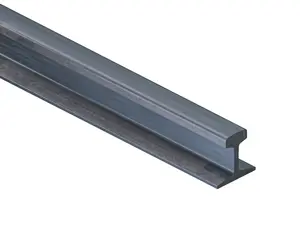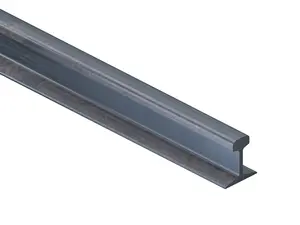Light rails
16 variantsIn the railroad world, standard solutions are not always suitable for every structure. Therefore, our offer takes into account the specific requirements of engineers and designers. We present lightweight and special rails - products dedicated to non-standard applications.
Characteristics of light and special rails
Light and special rails represent a category of steel products that are used in specific segments of the railroad industry. They are distinguished by unique design features and a production process adapted to specific technical and operational requirements.
Intermediate rails are a type of rail located between standard heavy and light rails. They are characterized by balanced strength and weight parameters, which makes them ideal for situations where a combination of durability and weight reduction is required. In the design of intermediate rails, it is crucial to maintain the ratio between the height of the head and the width of the base to ensure optimal distribution of the forces acting on the rail.
Narrow gaugerails, on the other hand, are designed for use in rail systems with smaller track widths. They exhibit a lower weight per unit length compared to standard rails, which is important in the context of infrastructure constraints and specific operating conditions, such as lower bridge load capacity and limited design capabilities of railroad vehicles.
Production of light and special rails is usually carried out by hot-rolling. The steel used in their production is carefully selected to meet stringent strength and flexibility requirements. The production process also includes a series of quality checks, such as tests for strength, flexibility and fatigue resistance, which is crucial to ensure safe and reliable operation.
Features and advantages of intermediate rails
Features of intermediate rails:
1.lightweight rail:
- Reduced weight per unit length.
- Optimized geometric proportions for better load distribution.
- High strength while maintaining flexibility.
2.narrow-gauge rail:
- Adaptation to a narrower track width.
- Lower weight, resulting in less strain on infrastructure.
- Design adapted to limited operating conditions.
Advantages of intermediate rail:
1.lightweight rail:
- Increased transportation efficiency due to weight reduction.
- Better fit for lighter rail vehicle designs.
- Longer service life with less material consumption.
2.narrow-gauge rail:
- Ability to operate in hard-to-reach or space-constrained areas.
- Lower construction and maintenance costs for rail infrastructure.
- Better maneuverability on narrow curves and short track sections.
Light and special rail profiles
We offer light and special rails with profiles of S24, S30, S30 DIN, S39, S10 DIN, S14 DIN, S18 and S20 DIN.
S24
Features:
- Weight of about 24.4 kg/m.
- Relatively low head height.
Advantages:
- Well suited for light transport applications , such as in the mining industry.
- Easy to install.
Disadvantages:
- Limited load carrying capacity and stability compared to heavier rails.
S30
Features:
- Weight of about 30.35 kg/m.
- Higher head than S24.
Advantages:
- Better stability than S24.
- Used in the mining industry.
Disadvantages:
- Higher weight can be a problem in very limited designs.
S30 DIN
Features:
- DIN5901 specification.
- Weight similar to 30.03 kg/m.
Advantages:
- Compliance with DIN standards.
- Versatility of applications.
Disadvantages:
- Similar to S30.
- Limitations in extreme conditions.
S39
Features:
- Weight of about 39.8 kg/m.
- Higher strength.
Advantages
- Suitable for heavier applications than S30.
Disadvantages:
- Higher weight, requires stronger subgrade infrastructure.
S10 DIN
Features:
- Lightest profile.
- DIN 5901 specification.
Advantages:
- Ideal for very light applications, such as recreational railroads and car washes.
Disadvantages:
- Limited strength and load carrying capacity.
S14 DIN
Features:
- Lightweight, but stronger than S10.
Advantages:
- Good compromise between weight and strength.
Disadvantages:
- Not suitable for heavy-duty applications.
S18
Features:
- Weight about 18.3 kg/m.
- Medium strength.
Advantages:
- Versatility of use in light transportation.
Disadvantages:
- Limitations in higher load applications.
S20 DIN
Features:
- DIN5901 specification.
- Weight approx. 19.8 kg/m.
Advantages:
- Good balance between weight and strength.
Disadvantages:
- May not be suitable for specialized applications.
Steel grades
We offer light and specialty rails in 167HB, 700, R200, R0550 and ST6 steels.
167HB
Features:
- Brinell hardness of approximately 167.
Advantages:
- Good wear resistance
- Relatively soft.
Disadvantages:
- Lower bending and pressure strength.
700
Features:
- High tensile strength.
Advantages:
- Excellent for heavy-duty applications
- High durability.
Disadvantages:
- Higher weight.
- More difficult to machine.
R200
Features:
- Tensile strength of about 200 MPa.
Advantages:
- Good versatility, used in various types of rails.
Disadvantages:
- Limitations under extremely heavy loads.
R0550
Features:
- Low tensile strength
- Flexible.
Advantages:
- Well suited for light applications where flexibility is required.
Disadvantages:
- Insufficient strength for heavy applications.
ST6
Features:
- Specialty steel with improved corrosion resistance.
Advantages:
- Ideal in conditions of increased moisture and corrosion.
Disadvantages:
- Higher cost than standard steels.
Application of light and special rails
The application of light and special rails covers a wide range in the railroad industry, with specific operational and construction requirements.
Intermediate ra ils are the optimal solution between standard heavy rails and light rail. Their use is ideal in situations where greater flexibility and lighter weight than standard rails are required, but where higher strength is needed than light rail offers. Intermediate types are often used in urban rail transportation systems where infrastructure constraints require lighter designs.
Narrow gauge rails are specifically designed for use in rail systems with smaller track gauges. Their main application is for narrow-gauge railroads, which are often used in tourism, forestry and mining industries, as well as in parks and recreational areas. They are characterized by lighter weight and are designed for smaller loads and limited space. This makes them ideal in areas where standard rail solutions are impractical or too costly.
Tips for investors
- Evaluate technical specifications - carefully evaluate the technical specifications of the rails before purchase to ensure that they meet the requirements of the project.
- Load analysis - pay attention to the loads the rails will have to withstand and the type of vehicles that will run on them.
- Analysis of operating conditions - verify the conditions under which the rails will be operated, including climatic, geographic and environmental issues.
- Use of appropriate steel grades - select the appropriate steel grade, taking into account requirements for strength, flexibility and corrosion resistance.
- Long-term cost analysis - consider not only the purchase cost, but also the long-term operation and maintenance costs.
- Fit with existing infrastructure - make sure that the selected rails will be compatible with existing rail infrastructure, if necessary.
Storage of light and special rails
Proper storage of light and special rails is key to maintaining their quality and functionality. Our recommendations:
- Horizontal stacking - rails should be stored horizontally on level and stable supports to prevent bending.
- Protection from corrosion - protect rails from moisture and corrosion by using appropriate protective coatings or store them in a dry and covered area.
- Maintaining spacing - maintain adequate spacing between stacks of rails to allow free access and prevent mechanical damage.
- Avoiding high storage - limit the height of storage to prevent the risk of tipping and to facilitate handling.
- Inspection and maintenance - regularly inspect the condition of rails in storage, verify their condition and clean them of any contamination.
Did you know.
- Narrow gauge rails were widely used in Europe in the 19th century, mainly in mining and forestry.
- Modern manufacturing technologies make it possible to produce lightweight rails with increased wear and load resistance, despite their lighter weight.
- Old rails are often recycled, recovering valuable materials and reducing environmental impact.
- Narrow gauge rails are often used in tourism, creating scenic rail routes in hard-to-reach areas.
Light and special rails - why with us?
At Moris Steel Wholesale, we have a wide selection of light and special rails to meet the various technical requirements of the railroad industry. Our team of experts provides professional service and advice to customize the offer to meet the individual needs of our customers. In addition, we offer flexible delivery options, tailored to the logistical requirements of each company, which guarantees fast and efficient delivery of orders.
We invite you to explore our range of light and special rails. Our products combine tradition and modernity, offering ideal solutions for railroad investors.
If you have questions or need advice on choosing the right product, we are at your service.
FAQ
What kind of steel are railroad rails made of?
Railroad rails are manufactured from high-strength steels that have been specially developed to meet the demands and loads associated with rail traffic.
The typical composition of steel used for railroad rails consists mainly of iron with additions of carbon, manganese, silicon and sometimes other elements that increase hardness, strength and wear resistance. Carbon, which is one of the main components, adds hardness to the steel and increases its wear resistance. Manganese, in turn, improves hardness and impact resistance, while silicon increases strength and helps the steelmaking process.
It's also worth mentioning that the rail manufacturing process, such as rolling or hardening, affects the final hardness and strength. The final choice of steel grade and production process depends on the requirements and technical specifications set by railroad operators, as well as industry standards.


